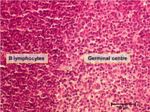Difference between revisions of "B cells"
Jump to navigation
Jump to search
| (15 intermediate revisions by 2 users not shown) | |||
| Line 1: | Line 1: | ||
| − | + | [[Image:LH B cells Peyers Patch Histology.jpg|right|thumb|150px|<p>'''B Cells in Lymph node'''</p><sup>©RVC 2008</sup>]] | |
| − | [[ | + | ''Also called B lymphocytes'' |
| + | <p>So named as they were initially found in the [[Bursa of Fabricius - Anatomy & Physiology|Bursa of Fabricius]]. They produce antibodies (Ig’s) and are associated with humoral immunity. They represent 20-30% of circulating lymphocytes. | ||
| + | B cells have B cell receptors (BCR), or antigen binding sites. This is [[IgM]] when the B cell is immature, changing to [[IgD]] when the cell is mature. B cells also express MHC II, CD9, CD,19, CD20 and CD24.</p> | ||
| + | <p>Under antigenic stimulation they differentiate into [[B cell differentiation#Plasma cells|plasma cells]] and [[B cell differentiation#Memory cells|memory cells]].</p> | ||
| − | + | B-cells also act as Antigen-Presenting Cells (APCs) by presenting digested fragments to T-cells on [[Major Histocompatability Complexes#MHC II|MHC II]]. | |
| − | + | For more on B cell differentiation, see [[B cell differentiation|here]]. | |
| − | |||
| − | |||
| − | |||
| − | |||
| − | |||
| − | |||
| − | |||
| − | |||
| − | |||
| − | |||
[[Category:Lymphocytes|B]] | [[Category:Lymphocytes|B]] | ||
Revision as of 19:11, 25 September 2010
Also called B lymphocytes
So named as they were initially found in the Bursa of Fabricius. They produce antibodies (Ig’s) and are associated with humoral immunity. They represent 20-30% of circulating lymphocytes. B cells have B cell receptors (BCR), or antigen binding sites. This is IgM when the B cell is immature, changing to IgD when the cell is mature. B cells also express MHC II, CD9, CD,19, CD20 and CD24.
Under antigenic stimulation they differentiate into plasma cells and memory cells.
B-cells also act as Antigen-Presenting Cells (APCs) by presenting digested fragments to T-cells on MHC II.
For more on B cell differentiation, see here.
